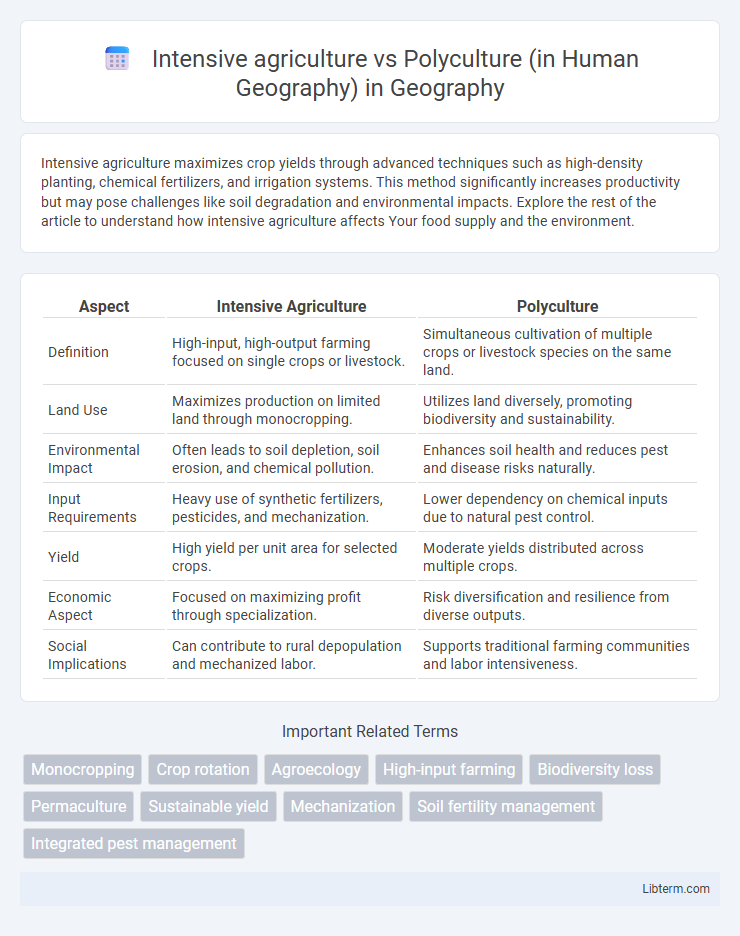Intensive agriculture maximizes crop yields through advanced techniques such as high-density planting, chemical fertilizers, and irrigation systems. This method significantly increases productivity but may pose challenges like soil degradation and environmental impacts. Explore the rest of the article to understand how intensive agriculture affects Your food supply and the environment.
Table of Comparison
| Aspect | Intensive Agriculture | Polyculture |
|---|---|---|
| Definition | High-input, high-output farming focused on single crops or livestock. | Simultaneous cultivation of multiple crops or livestock species on the same land. |
| Land Use | Maximizes production on limited land through monocropping. | Utilizes land diversely, promoting biodiversity and sustainability. |
| Environmental Impact | Often leads to soil depletion, soil erosion, and chemical pollution. | Enhances soil health and reduces pest and disease risks naturally. |
| Input Requirements | Heavy use of synthetic fertilizers, pesticides, and mechanization. | Lower dependency on chemical inputs due to natural pest control. |
| Yield | High yield per unit area for selected crops. | Moderate yields distributed across multiple crops. |
| Economic Aspect | Focused on maximizing profit through specialization. | Risk diversification and resilience from diverse outputs. |
| Social Implications | Can contribute to rural depopulation and mechanized labor. | Supports traditional farming communities and labor intensiveness. |
Introduction to Intensive Agriculture and Polyculture
Intensive agriculture involves high-input farming techniques that maximize yield per unit area through mechanization, synthetic fertilizers, and pesticides, commonly practiced in industrialized regions for staple crops like wheat and rice. Polyculture, by contrast, integrates diverse crop species and sometimes livestock within the same space, promoting biodiversity, soil health, and resilience against pests, often utilized in traditional and sustainable farming systems. Human geography examines these agricultural systems to understand their environmental impacts, cultural significance, and roles in food security across different spatial scales.
Historical Development of Farming Systems
Intensive agriculture emerged with the advent of industrialization, emphasizing high-yield monoculture crops, mechanization, and chemical inputs to maximize production on limited land. Polyculture, rooted in traditional subsistence farming, involves cultivating multiple crop species simultaneously, promoting biodiversity and soil health through sustainable practices. Historical development shows a shift from diverse, labor-intensive polyculture systems toward specialized intensive agriculture driven by population growth and economic demands.
Core Principles: Intensive Agriculture
Intensive agriculture maximizes crop yield per unit area through high inputs of labor, fertilizers, and irrigation, often relying on monoculture practices to enhance efficiency. This method emphasizes technological advancements and mechanization to increase productivity in limited spaces, primarily in densely populated core regions. Intensive agriculture contrasts with polyculture by prioritizing specialization and output optimization over biodiversity and ecological balance.
Core Principles: Polyculture
Polyculture in human geography emphasizes biodiversity by cultivating multiple crop species and livestock together, enhancing ecosystem resilience and soil health. This approach reduces dependency on chemical inputs and mitigates pest outbreaks through natural pest control and crop diversity. Polyculture supports sustainable land use by mimicking natural ecosystems, promoting economic stability for farmers via diversified production.
Environmental Impacts Compared
Intensive agriculture often leads to significant soil degradation, water pollution from chemical runoff, and loss of biodiversity due to monoculture practices. Polyculture, by contrast, enhances soil fertility, reduces pest outbreaks naturally, and promotes biodiversity by cultivating multiple crop species simultaneously. The environmental impact of polyculture is generally more sustainable, supporting ecosystem resilience and reducing the need for synthetic inputs.
Socio-Economic Implications
Intensive agriculture generates high yields through significant inputs of labor, capital, and technology, often benefiting commercial farming economies but increasing rural inequality by marginalizing smallholders. Polyculture fosters biodiversity and sustainable land use, supporting diverse livelihoods and food security in rural communities while limiting market scalability. Socio-economically, intensive systems drive urban migration and wage labor dependence, whereas polyculture maintains traditional farming cultures and local economies.
Land Use and Productivity Analysis
Intensive agriculture maximizes land productivity by employing high inputs of labor, fertilizers, and irrigation on relatively small land areas to produce large yields per hectare. Polyculture enhances land use efficiency by cultivating multiple crop species simultaneously, promoting biodiversity and reducing soil depletion, which can sustain productivity in the long term. Land use analysis reveals that intensive agriculture often leads to land degradation, while polyculture supports ecosystem services and can improve overall productivity through biological interactions.
Cultural and Regional Case Studies
Intensive agriculture in the Indo-Gangetic Plain exemplifies high-yield monocropping systems reliant on mechanization and chemical inputs, sustaining dense populations through rice and wheat cultivation. In contrast, the Andean regions of Peru demonstrate polyculture practices integrating potatoes, maize, and quinoa within terraced fields, fostering biodiversity and resilience to climate variability rooted in indigenous knowledge. These divergent agricultural models reflect cultural adaptations and regional ecological conditions shaping food security and land use patterns in human geography.
Future Trends in Agricultural Practices
Future trends in agricultural practices emphasize a shift from intensive agriculture, characterized by monoculture and heavy input use, to sustainable polyculture systems that enhance biodiversity and soil health. Polyculture integrates multiple crops and livestock, improving ecosystem resilience and reducing dependency on chemical fertilizers and pesticides. Advances in agroecology, precision farming, and climate-smart agriculture support this transition to more sustainable, efficient, and environmentally friendly food production methods worldwide.
Conclusion: Weighing the Pros and Cons
Intensive agriculture maximizes yield per unit area through mechanization and chemical inputs but often leads to soil degradation and biodiversity loss. Polyculture promotes ecosystem resilience and sustainable resource use by cultivating multiple crops simultaneously but may result in lower immediate productivity. Balancing the efficiency of intensive agriculture with the environmental benefits of polyculture is essential for achieving long-term food security and ecological health.
Intensive agriculture Infographic

 libterm.com
libterm.com